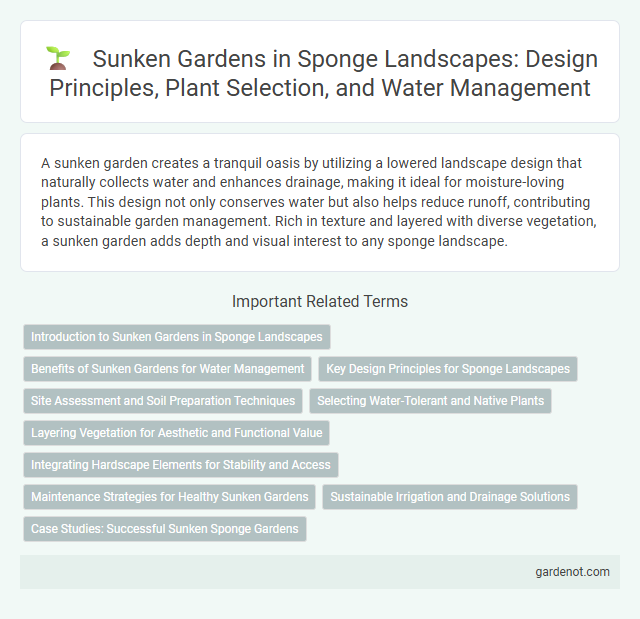A sunken garden creates a tranquil oasis by utilizing a lowered landscape design that naturally collects water and enhances drainage, making it ideal for moisture-loving plants. This design not only conserves water but also helps reduce runoff, contributing to sustainable garden management. Rich in texture and layered with diverse vegetation, a sunken garden adds depth and visual interest to any sponge landscape.
Introduction to Sunken Gardens in Sponge Landscapes
Sunken gardens in sponge landscapes serve as natural water retention basins that enhance stormwater management by capturing and slowly infiltrating runoff. These gardens support diverse plant species adapted to fluctuating moisture levels, promoting biodiversity and soil stabilization. Integrating sunken gardens improves urban resilience by reducing flood risks and replenishing groundwater resources.
Benefits of Sunken Gardens for Water Management
Sunken gardens effectively capture and retain stormwater, reducing surface runoff and minimizing flood risks in urban areas. Their design promotes natural water infiltration, replenishing groundwater and improving soil moisture levels. These water management benefits aid in sustainable landscaping and enhance local ecosystem health.
Key Design Principles for Sponge Landscapes
Sunken gardens in sponge landscapes utilize key design principles such as strategic elevation lowering to capture and retain stormwater, promoting natural infiltration and groundwater recharge. Incorporating native vegetation with deep root systems enhances soil permeability and reduces surface runoff, while multi-layered planting structures maximize water absorption and biodiversity. Permeable soil mediums and contouring are essential to direct water flow efficiently into the basin, preventing erosion and optimizing the garden's sponge function.
Site Assessment and Soil Preparation Techniques
Sunken garden design in sponge landscapes requires thorough site assessment including soil permeability, drainage capacity, and topography to prevent waterlogging and promote optimal water retention. Soil preparation techniques prioritize aeration through deep tilling and incorporation of organic matter, enhancing infiltration and nutrient availability suitable for diverse plant species. Proper grading and installation of permeable layers ensure efficient absorption and reduce runoff, crucial for maintaining a sustainable sunken garden ecosystem.
Selecting Water-Tolerant and Native Plants
Choosing water-tolerant and native plants for a sunken garden ensures resilience to fluctuating moisture levels while supporting local biodiversity. Species such as pickerelweed, cardinal flower, and swamp milkweed thrive in saturated soils and provide habitat for pollinators. Using native plants reduces maintenance needs and enhances the ecological harmony of the sponge landscape design.
Layering Vegetation for Aesthetic and Functional Value
Layering vegetation in a sunken garden enhances both aesthetic appeal and functional benefits by creating depth and texture through diverse plant heights and types. Utilizing a combination of ground covers, shrubs, and small trees establishes microclimates that support moisture retention and reduce soil erosion within the recessed landscape. Strategic plant selection also promotes biodiversity and attracts pollinators, contributing to a healthier and more resilient sunken garden ecosystem.
Integrating Hardscape Elements for Stability and Access
In a sunken garden within a sponge landscape, integrating hardscape elements like retaining walls, stepped pathways, and non-permeable edging ensures stability by preventing soil erosion and maintaining structural integrity during heavy rainfall. Materials such as stone, concrete, or durable timber provide firm access points that withstand frequent water saturation while complementing the garden's natural infiltration system. Strategic placement of these elements enhances both functionality and aesthetic appeal, supporting the sponge landscape's goal of efficient water management and sustainable outdoor use.
Maintenance Strategies for Healthy Sunken Gardens
Effective maintenance strategies for healthy sunken gardens include regular water management to prevent waterlogging and ensure optimal drainage. Incorporating organic mulch and soil amendments enhances nutrient retention and promotes healthy root development. Routine pruning of plants and removal of debris reduce disease risk and encourage vigorous growth in sunken garden landscapes.
Sustainable Irrigation and Drainage Solutions
Sunken gardens utilize sponge landscape techniques to optimize sustainable irrigation by capturing and retaining rainwater, reducing runoff and water waste. These designs incorporate permeable soils and layered drainage systems that enhance groundwater recharge and prevent soil erosion. Employing bio-retention basins and native vegetation promotes natural filtration and maintains ecological balance within the garden.
Case Studies: Successful Sunken Sponge Gardens
Successful sunken sponge gardens showcase innovative water management with natural filtration systems that maximize rainwater absorption and reduce urban runoff. Case studies from Singapore and the Netherlands highlight the integration of native plant species and layered soil structures, enhancing biodiversity while maintaining structural integrity. These designs demonstrate how combining spongy soil substrates with strategic plant selection creates resilient, aesthetically pleasing landscapes that mitigate flooding and improve groundwater recharge.
Sunken garden Infographic

 gardenot.com
gardenot.com